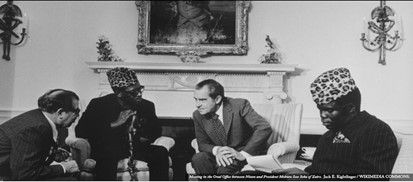African Connection of Atom Bomb That Destroyed Hiroshima
Posted on August 26th, 2023
By Lisa Vives, Global Information Network

Meeting in the Oval Office between President Nixon and President Mobutu of Zaire, known as Democratic Republic of Congo (DRC) since 1997. The uranium used in making the bomb and subsequent atomic weapons were sourced from the DRC. Credit: Jack Kightlinger | Wikimedia Commons. – Photo: 2023
NEW YORK. 24 August 2023 (IDN) — This month marks the anniversary of the first use of an atomic bomb, developed in the U.S. and dropped on a Japanese city to deadly effect.
Little is known, however, of the African connection to this deadly weapon—namely the use of uranium in making the bomb and subsequent atomic weapons —all of the mineral sourced from the Democratic Republic of the Congo.
To develop the weapon, the U.S. started The Manhattan Project in 1939, stationed in Los Alamos, New Mexico, and headed by the American physicist, J. Robert Oppenheimer.
A large amount of uranium used in making the first atomic weaponry was sourced from the Shinkolobwe mine in the Katanga province of the DRC. First discovered in 1915 and under Belgian colonial rule, the mine was manned by Congolese laborers to produce uranium for the U.S.
These laborers worked under secret contracts and low wages for the United States national security. To prevent information from leaking, Shinkolobwe was erased from maps and the then Prime Minister of the United Kingdom, Winston Churchill, referred to the uranium as an ‘indispensable raw material for the project’.
Misinformation was also spread to make it appear that they were sourced from Canada, whose ores yielded 0.03 percent uranium while Congolese ores yielded 65 percent uranium.
The Shinkolobwe mine in the Katanga province of the Belgian Congo provided two-thirds of the Manhattan Project’s uranium from an extraordinarily rich pitchblende deposit averaging more than 2 percent uranium content.
The word Shinkolobwe fills me with grief and sorrow,” says Susan Williams, a historian at the UK Institute of Commonwealth Studies. It’s not a happy word, it’s one I associate with terrible grief and suffering.”
Few people know what, or even where, Shinkolobwe is. But this small mine in the southern province of Katanga, in the Democratic Republic of the Congo (DRC), played a part in one of the most violent and devastating events in history.
This month, more than 7,500 miles away, bells tolled across Hiroshima, Japan, to mark 75 years since the atomic bomb fell on the city. Thousands of lanterns carrying messages of peace will be set afloat on the Motoyasu River. Three days later, similar commemorations were held in Nagasaki.
No such ceremony will take place in the DRC. Yet both nations are inextricably linked by the atomic bomb, the effects of which are still being felt to this day.
When we talk about the Hiroshima and Nagasaki bombing, we never talk about Shinkolobwe,” says Isaiah Mombilo, chair of the Congolese Civil Society of South Africa. Part of the Second World War has been forgotten and lost.”
Ultimately, the Congolese mine furnished nearly two-thirds of the uranium used for the bomb (nicknamed Little Boy”) dropped on Hiroshima, and it also contributed to the production of much of the plutonium used in the bomb (Fat Man”) dropped on Nagasaki three days later. [IDN-InDepthNews]
Photo: Meeting in the Oval Office between President Nixon and President Mobutu of Zaire, known as the Democratic Republic of Congo (DRC) since 1997. The uranium used in the bomb and subsequent atomic weapons were sourced from the DRC. Credit: Jack Kightlinger | Wikimedia Commons.
IDN is the flagship agency of the International Press Syndicate.
We believe in the free flow of information. Republish our articles for free, online or in print, under Creative Commons Attribution 4.0 International, except for republished articles with permission.